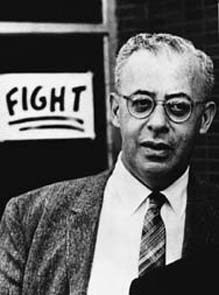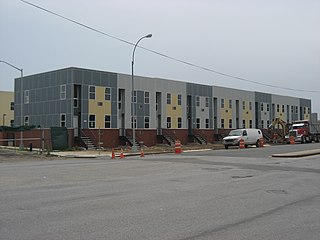
Saul David Alinsky was an American community activist and political theorist. His work through the Chicago-based Industrial Areas Foundation helping poor communities organize to press demands upon landlords, politicians, bankers and business leaders won him national recognition and notoriety. Responding to the impatience of a New Left generation of activists in the 1960s, Alinsky – in his widely cited Rules for Radicals: A Pragmatic Primer (1971) – defended the arts both of confrontation and of compromise involved in community organizing as keys to the struggle for social justice.
Thomas A. Gaudette (1923–1998) was a community organizer who worked in the Austin neighborhood of Chicago. Originally a businessman, Gaudette became interested in neighborhood organizing through his Catholic Church activism. Gaudette helped form a neighborhood group, along the lines of those organized by Saul Alinsky, on the far West Side of Chicago called Organization for a Better Austin. OBA was concerned with poor schools and neighborhood decline.
Ernesto Cortés Jr. is the Industrial Areas Foundation (IAF) co-chair and executive director of the West / Southwest IAF regional network.

Community organizing is a process where people who live in proximity to each other or share some common problem come together into an organization that acts in their shared self-interest.

Nicholas von Hoffman was an American journalist and author. He first worked as a community organizer for Saul Alinsky in Chicago for ten years from 1953 to 1963. Later, Von Hoffman wrote for The Washington Post, and most notably, was a commentator on the CBS Point-Counterpoint segment for 60 Minutes, from which Don Hewitt fired him in 1974. von Hoffman was also a columnist for The Huffington Post.

New City is one of Chicago's 77 official community areas, located on the southwest side of the city in the South Side district. It contains the neighborhoods of Canaryville and Back of the Yards.
Staughton Craig Lynd was an American political activist, author, and lawyer. His involvement in social justice causes brought him into contact with some of the nation's most influential activists, including Howard Zinn, Tom Hayden, A. J. Muste, and David Dellinger.
John Joseph Egan was an American Roman Catholic priest and social activist.
The United Packinghouse Workers of America (UPWA), later the United Packinghouse, Food and Allied Workers, was a labor union that represented workers in the meatpacking industry.

Rules for Radicals: A Pragmatic Primer for Realistic Radicals is a 1971 book by community activist and writer Saul D. Alinsky about how to successfully run a movement for change. It was the last book written by Alinsky, and it was published shortly before his death in 1972. His goal was to create a guide for future community organizers, to use in uniting low-income communities, or "Have-Nots", in order for them to gain by any effective, non-violent means social, political, legal, environmental and economic wealth and power. Inside of it, Alinsky compiled the lessons he had learned throughout his experiences of community organizing from 1939 to 1971. He targeted these lessons at the current, new generation of radicals.
Edward Thomas Chambers was the executive director of the Industrial Areas Foundation from 1972 to 2009, a community organizing group founded by Saul Alinsky. Chambers was born in Clarion, Iowa to Thomas Chambers and Hazella Downing. He is credited with developing systematic training of organizers and leaders of congregation-based community organizations, and establishing relational meetings as a critical practice of organizers. He is the author of Roots for Radicals: Organizing for Power, Action, and Justice. A memorial article in The New Yorker called him "community organizing’s unforgiving hero." He died of heart failure in Drimoleague, Ireland in 2015.
Michael Gecan is a community organizer in New York City affiliated with the Industrial Areas Foundation. He was trained in part by Saul Alinsky. He is lead organizer for East Brooklyn Congregations and other New York-based organizations. He is the executive director of United Power for Action and Justice, a Chicago Based Industrial Area Foundation affiliate. He is the author of Going Public: An Organizer's Guide to Citizen Action. ISBN 1-4000-7649-8.

East Brooklyn Congregations is a congregation-based community organizing serving several neighborhoods in New York City. Formed in 1980, it is affiliated with the Industrial Areas Foundation and headed by Michael Gecan. EBC is best known for founding Nehemiah Homes, which has constructed several affordable housing developments since the late 1980s in the Eastern Brooklyn neighborhoods of Flatbush, East New York, and Spring Creek. It has been involved in the formation of three public New York City high schools: EBC East New York, EBC Bushwick High School for Public Service, and Bushwick Leaders' High School for Academic Excellence.
Communities Organized for Public Service (COPS) is a coalition of non-partisan, grassroots community pressure groups based in San Antonio, Texas. It is an affiliate of the Industrial Areas Foundation (IAF), a group dedicated to grassroots community organizing that was developed by Saul Alinsky in Chicago during the 1930s. Founded in 1974, COPS’ mission is to secure specific, concrete standard of living improvements for neighborhoods traditionally neglected by city leaders through relational organizing.
Community organizing describes a wide variety of efforts to empower residents in a local area to participate in civic life or governmental affairs. Most efforts that claim this label operate in low-income or middle-income areas, and have adopted at least some of the tactics and organizing techniques pioneered by Saul Alinsky and his Industrial Areas Foundation. Other organizations in this tradition include PICO National Network, Gamaliel Foundation, and Direct Action and Research Training Center (DART).

Marshall Field III was an American investment banker, publisher, racehorse owner/breeder, philanthropist, grandson of businessman Marshall Field, heir to the Marshall Field department store fortune, and a leading financial supporter and founding board member of Saul Alinsky's community organizing network Industrial Areas Foundation.
Gamaliel Foundation provides training and consultation and develops national strategy for its affiliated congregation-based community organizations. As of 2013, Gamaliel has 45 affiliates in 17 U.S. states, the United Kingdom, and South Africa, and claims to represent over a million people.
Faith in Action, formerly known as Pacific Institute for Community Organization, is a national network of faith-based community organizations in the United States. The organization is headquartered in Oakland, California, with additional offices in San Diego and Washington, D.C. The organization believes in a society free of economic oppression, racism and discrimination. Its stated mission is "to increase access to health care, improve public schools, make neighborhoods safer, build affordable housing, redevelop communities and revitalize democracy."
George W. Hill was an American Baptist pastor, a peace activist, and a leading liberal Protestant voice who played an important role in the founding of the United States Institute of Peace.

The White-Meyer House is a historic mansion in Washington, D.C., located in the Meridian Hill neighborhood of Northwest D.C. It was designed by American architect John Russell Pope and built by order of American diplomat Henry White. For several years, the house was rented to Eugene Meyer, who then bought it in 1934. It was bought by non-profit organization Meridian International Center in 1987.






